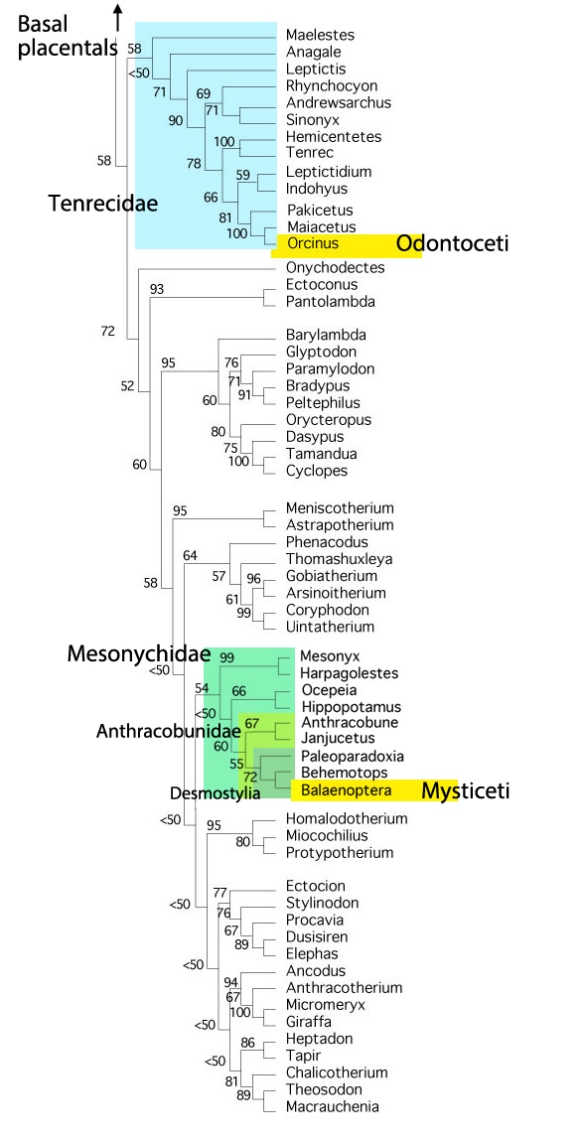

| Online: | |
| Visits: | |
| Stories: |
The desmostylian ?Behemotops is basal to the Mysticeti (baleen whales)
Backstory:
Traditional paleontology nests desmostyians with proboscidians (elephants) and sirenians. By contrast, the large reptile tree (LRT) nests desmostylians with hippos, anthracobunids, mesonychids and, pertinent to the present discussion, mysticetes (baleen whales) like Balaenoptera, the blue whale (Figs. 1, 2).

Figure 1. ?Behemotops cf. proteus as originally published, after lifting the posterior maxilla, with the addition of a warped Balaenoptera mandible and compared to Balaenoptera. Note the holotype of Behemotops, the short, toothy mandible at upper left, would never fit the long rostrum of the cf. specimen. The long and large humerus does not indicate that flippers were present here.
More backstory:
The desmostylian Behemotops proteus (Domning, Ray and McKenna 1986, Beatty and Cockburn 2015; Oligocene, 34-23 mya) was originally described on the basis of short, deep, but largely complete (missing the retroarticular process) and immature (unerupted molars) mandible USNM 244035 (Fig. 1). Another short, deep mandible with a distinctly different architecture and preserving the retroarticular process, USNM 244033 was also also assigned to this genus (Fig. 1), IMHO in error. Neither of these short mandibles appear to fit the long skull of another specimen tentatively assigned to this genus, Behemotops cf. proteus RBCM.EH2007.008.0001 (Fig. 1), which preserves the left half of much of the skull, but no mandible or cranium. An imaginary mandible has been supplied here (Fig. 1) based on phylogenetic bracketing and… it’s a good fit when warped to fit.
We need to come up with new genus
for the RBCM specimen.
This is more evidence
that extant whales are not monophyletic and that desmostylians are not extinct. They live on as baleen whales.

Figure 2. Blue whale (Balaenoptera musculus) skull and skeleton. Note the lack of a thumb goes back to Mesonyx and Paleoparadoxia
The resemblance of Behemotops
to the blue whale, Balaenoptera (Figs. 1, 2), is striking. Available post-cranial material for Behemotops (one relatively big humerus in Fig. 1) does not indicate flipper development (Fig. 2).
A phylogenetic fix is needed.
Earlier I reported on Janjucetus, which was considered the most basal mysticete whale by Fitzgerald 2006. Unfortunately revisiting the data indicates that leaf-toothed Janjucetus is now more closely related to Anthracobune, a small taxon known from more plesiomorphic teeth and most of a skull (no post-crania). Even so, with long-legged desmostylians now nesting between Janjucetus and Balaenoptera (Fig. 4), phylogenetic bracketing indicates that, despite their dorsal nares, Janjucetus and Anthracobune both had legs, like desmostylians, not flippers. So Janjucetus is not the most basal mysticete and its very distinct teeth are not precursors or placeholders to baleen.

Figure 3. Subset of the LRT, higher placental mammals with a focus on whales (yellow) and their ancestral clades, the Tenrecidae and Mesonychidae. Both are a fair distance from artiodactyls. Note the new nesting of Janjucetus with Anthrobune and Behemotops with Balaenoptera.
References
Beatty BL and Cockburn TC 2015. New insights on the most primitive desmostylian from a partial skeleton of Behemotops (Desmostylia, Mammalia) from Vancouver Island, British Columbia. Journal of Vertebrate Paleontologoy 35(5):e979939: 15 pp.
Cockburn TC and Beatty BL 2009. A Partial Skeleton of Behemotops (Desmostylia, Mammalia) from Vancouver Island, British Columbia. Journal of Vertebrate Paleontology. 29 (3, Supplement): 1A–211A.
Domning DP, Ray, CE and McKenna, MC 1986. Two new Oligocene desmostylians and a discussion of Tethytherian systematics. Smithsonian Contributions to Paleobiology. 59. pp. 1–56.
Fitzgerald EMG 2006. A bizarre new toothed mysticete (Cetacea) from Australia and the early evolution of baleen whales. Proceedings of the Royal Society B 273:2955-2963.
wiki/Janjucetus
wiki/Behemotops
Source: https://pterosaurheresies.wordpress.com/2016/11/09/the-desmostylian-behemotops-is-basal-to-the-mysticeti-baleen-whales/



